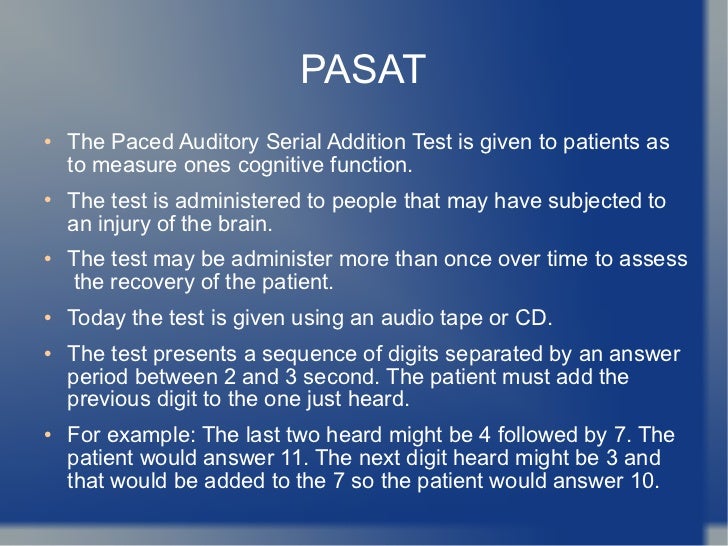Paced Auditory Serial Addition Test
The Paced Auditory Serial Addition Test (PASAT) is a measure of cognitive function that specifically assesses auditory information processing speed and flexibility, as well as calculation ability. It was initially developed by Gronwall in 1977 (1) to monitor the recovery of. The Paced Auditory Serial Addition Test (PASAT) is a test of serial addition designed to assess information processing speed, working memory, and divided attention. The Paced Auditory Serial Addition Test (PASAT) is a measure of cognitive function that specifically assesses auditory information processing speed and flexibility, as well as calculation ability. It was initially developed by Gronwall in 1977 (1) to monitor the recovery of patients who had sustained mild. The cognitive component of MSFC is the Paced Au- ditory Serial Addition Test (PASAT). This consists of dif- ficult serial addition of numbers, and it ultimately as- sesses information-processing speed and/or working memory4.

- Block design
- Auditory PASAT: Present a continual sequence of numbers at a fixed pace
- Patient must add the last 2 numbers in their mind each time a new number is presented
- Visual PASAT: Numbers are displayed one at a time on the screen at a fixed pace
- “You will be presented with a sequence of numbers; each time you hear a new number, add it to the previous number in your mind”
- Distortion, motion, slice timing correction, coregistration to MPRAGE, optional smoothing
- General linear model: Block design
- Activates dorsolateral prefrontal (Brodmann 9, 46), intraparietal sulcus (7, 40), lateral premotor (6), SMA (32), frontal eye fields (8), and medial cerebellum
- Visual attention (cursor, visual search, random pattern comparison) or working memory tasks (Sternberg, n-back, Tower of London)
- Used in group designs to assess performance of working memory in patient populations
- Used in individual subjects for presurgical mapping
Paced Auditory Serial Addition Test Norms
- Difficult to assess task performance
How To Do Serial Additions

Activation map for an auditory PASAT task is shown for 1 patient. Image is the average of 2 sequences, 6-minutes each. Hot colors show greater activation during the PASAT blocks, and cool colors show greater activation during the rest blocks. Significance is set at q < 0.05, false discovery rate corrected. For the task, the patient listened to a list of single-digit numbers. Each time a new number was heard, she added in her mind the previous 2 numbers. Rest blocks contained no stimuli. Task activation is seen in auditory cortex, dorsolateral prefrontal cortex, intraparietal sulcus, medial cerebellum, frontal eye fields, and supplementary motor area. |


You may also need
